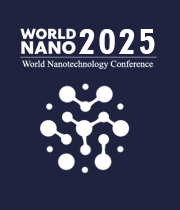Title : Adsorption and Recovery of Rare Earth Elements (REEs) using copper imidazolate (BNMG-1) metal organic framework from electronic waste
Abstract:
This study attempts to address the pressing need for recovery of rare earth elements (REEs) from secondary sources such as e-waste, wastewater, coal mines etc. We study the adsorption mechanism of five critical REEs (Yttrium, Neodymium, Terbium, Europium, and Dysprosium) using hydrolytically stable Copper- imidazolate metal-organic framework (BNMG-1 MOF) nanoparticles. The synthesis of BNMG-1 MOF was achieved through a straightforward, single-step process at room temperature using copper nitrate and 2- methyl imidazole. SEM micrograph showed that the BNMG-1 exhibit uniform nanosheet like structure with thickness of 14 ± 4 nm and BET-specific surface area of 18 m2/g. Prepared BNMG-1 nanoparticles were used for the batch adsorption experiments, demonstrating the exceptionally high adsorption capacity with fast adsorption process for all critical REEs. The Langmuir model yielded theoretical adsorption capacities of 323.6, 355.8, 331.1, 328.9, and 333.3 mg/g for Y(III), Nd(III), Dy(III), Tb(III), and Eu(III), respectively. Adsorption isotherm and kinetics were modelled, revealing a process characterized by monolayer formation and chemisorption for all REEs. SEM-EDS, XRD, and XPS analyses were conducted to validate the adsorption mechanism and assess the structural stability of Cu-Im MOF before and after adsorption. Results indicated that the MOF structure remained stable following REE adsorption. The notable features of high adsorption capacity and reusability led to the selection of BNMG-1 for REE recovery. The study extended its applicability by testing the adsorption process on real waste samples, such as fluorescent lamp and NdFeB magnets. Remarkably, within one hour, 27% of Y(III) and 57% of Nd(III) were removed from the leached magnet waste solution, highlighting the potential of Cu-Im MOF as an effective adsorbent for REE recovery from aqueous solutions.
Audience Take Away Notes:
- Adsorption mechanism of REEs on MOF, Novel metal organic framework developed in BNMG lab at IIT Gandhinagar, India
- New method to recover rare earth elements from waste products
- The recycling of REEs from e-wastes would mark a pivotal frontier in sustainability efforts, addressing the environmental burden of excessive mining, while meeting the growing demands for these elements due to a meteoric increase in their usage for electronics
- Single-step synthesis, high specificity, reusability, near-benchmark REE+3 uptakes of BNMG-1 MOF. We anticipate that the philosophy underpinning the principles of materials design employed herein, will drive forward new paradigms for accelerating sustainability efforts, in particular the recycling of REEs, and as a natural extension, precious metals


